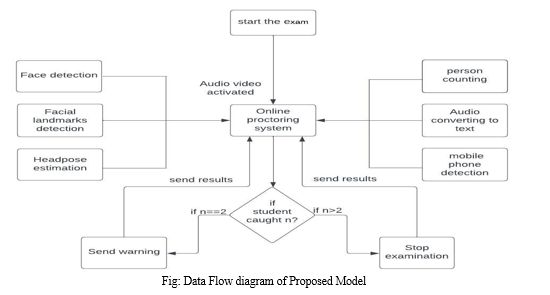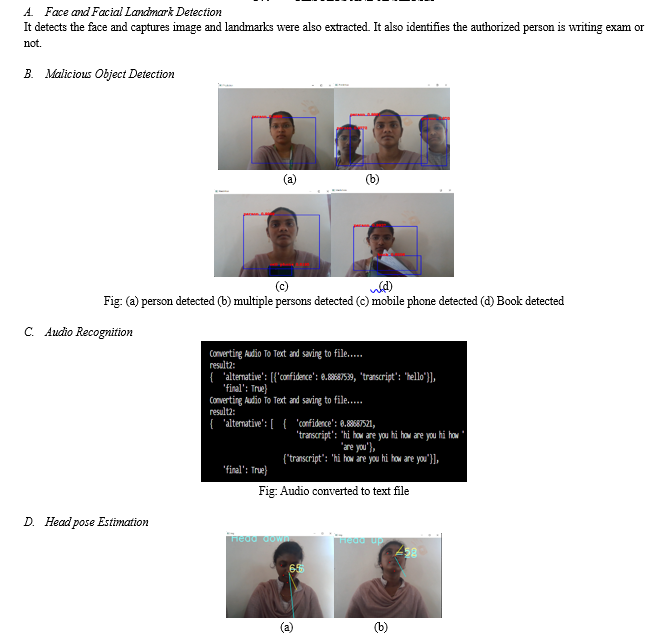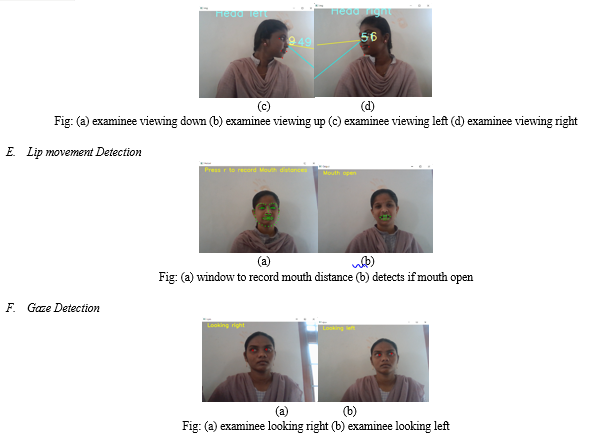Ijraset Journal For Research in Applied Science and Engineering Technology
- Home / Ijraset
- On This Page
- Abstract
- Introduction
- Conclusion
- References
- Copyright
Streamlining Exam Proctoring Process Using Python
Authors: Kota Chandra Bhanu, Vennapusala Apurva, Madasani Yamini Sridevi, Kothapalli Manju, Mallampati Pallavi, Mrs. Palepu Neelima
DOI Link: https://doi.org/10.22214/ijraset.2023.50906
Certificate: View Certificate
Abstract
COVID-19 has brought about drastic change in education systems around the world. Many schools, colleges and universities have chosen online education to complement their courses. For this reason, students have moved to a world of technology where they are motivated to read, practice, and perform in online mode. Students should also be analysed using only online platforms. Therefore, online exams are an integral part of this online education system. But here, students are not supervised by humans, leading to cheating and negligence in exams. Since the exam will be online, an online supervision system is required where candidates can be supervised during the exam without the direct presence of the proctor. In this project, we found a solution to this problem, thus maintaining the academic integrity of the exams. So, the idea included creating a remote monitoring system where students could be monitored via webcam and microphone, which could identify any instances of misconduct in the online examination.
Introduction
I. INTRODUCTION
In recent years, online education has grown exponentially. Due to the pandemic, educational institutions have paved the way for the delivery of online education to students. Many platforms have introduced online courses and certification exams to help students improve their skills and knowledge. There are also free online courses that are really a great opportunity for students to focus more on their interests. Many competitions and job postings from companies also take place online. Hence, it is necessary to monitor the students whether they are cheating or not as there are many methods to carry out cheating activities.
A. Motivation
Online exam monitoring systems can be a great tool to ensure the integrity of online exams and prevent fraud. Here are some possible reasons for implementing an online exam control system in your project: Ensuring academic integrity, Consistency, Affordable, Convenience, Compliance, Data and Analysis. Overall, an online exam tracking system can help maintain the credibility of exams and results while providing convenience, convenience, and data-driven information.
???????B. Objective
The design goal of the online exam monitoring system is to ensure the integrity of online exams by preventing fraud and providing a secure testing environment. The system is designed to monitor and authenticate candidate identity, detect and prevent fraud, and maintain an exam session log for review and analysis. The primary purpose of the online exam proctoring system is to ensure that exam results accurately reflect the candidate's knowledge and ability and that the integrity of the exam process is maintained. Using various technologies such as artificial intelligence, facial recognition and screen monitoring, the system is able to detect suspicious behaviour and alert the caregiver in real time. The online exam monitoring system is also designed to allow the candidate to test smoothly with minimal disruption and disruption. The system should be easy to use, reliable and accessible from anywhere with internet access.
???????C. Existing System
Monitoring of all students is required in the existing system as there are more ways and opportunities for a candidate to cheat in an online exam. In our existing system, this applies to the following topics: emotion detection, head position estimation, cell phone, book, and other person detection.
With emotion recognition, the candidate's emotions are recorded during the exam, regardless of whether they are cheating or not. The online test taker's emotions make it easy for the supervisor to tell if the taker is trying to cheat on the exam or not. When assessing head position, the movement of the candidate's head during the exam is the sign of cheating. In the detection of mobile phones, books, and other people (malicious activities), when malicious activities are detected, the teacher becomes aware of the candidate's cheating.
???????D. Proposed System
This system consists of basic components that continuously estimate candidate behaviour. We have a webcam to take video input which is used to determine several factors like emotion detection, posture estimation of the head and mobile phones, books and many people are used to detect possible malicious behaviour during the examination. The Face processing system detects the face and the facial landmarks.
We first detect the face and it is taken as input image, then the facial landmarks are extracted, since this is a trained model, it stored 68 facial landmarks.
Malicious object detection is when multiple people, cell phones and books are detected while a student is taking an exam, it leads to exam cheating. Sound Recognition is to make exams serious and academically effective. Through "OEP" We need to observe the candidate's audio and video to detect any fraud. We add several other modules to the proposed system, namely eye detection, noise detection, head posture estimation.
II. LITERATURE REVIEW
W [1] Vidhya SG*1, Ms. Hema GA*2, Ms. Jeevitha MG*3, page. Nischitha KB*4, Ms. Vandana*5 (2022) Reviewed several articles on AI-BASED ONLINE TEST PROCESSING SYSTEM. For several years, the number of online exams has been increasing due to COVID-19. In this pandemic situation, schools/universities are starting to take exams online. During the online exams, we developed several techniques and tools to prevent fraud. Using an AI-supported model, we detect fraud during the online exam.
Aditya Nigam, Rhitvik Pasricha, Tarishi Singh, Prathamesh Churi (2021) in [2] They used artificial intelligence in this reference article. The COVID-19 pandemic has provided more resources for students everywhere to learn, understand, and improve. Online Monitoring System (Evaluation Section) &Amp; AI-based surveillance systems are also referred to as AIPS. Online monitoring systems often require online tools to maintain the integrity of the online exam. Some parameters, such as psychological, cultural, and technological parameters, need to be considered when developing PSIA. Key issues include security and privacy, trust in AI-powered technology, cost-efficiency, and ethical issues.
Authors, Butler-Henderson, K., & Crawford, J. (2020) provided a comprehensive systematic review of online reviews in [3]. All industries are preceded by digitization and automation, which has led to improvements in efficient systems. This document provides a brief description of the online verification process. Here we examine nine key themes: Safety, Student Achievement, Staff Perceptions, Anxiety, Interface Design, Student Perceptions, Intimacy, and Technology Issues.
W [4], Focus by Y. Atum, L. Chen, A.X. Liu, S. DH Hsu and X Liu, Automated Checking of Online Exams (2017). The article is about the multimedia analysis system that supports online exams. Many students take Mass Open Online Courses (MOOCS) and other online courses with certificates. This system includes six main components that continually assess student behaviour: User Verification, Text Recognition, Speech Recognition, Active Window Detection, Gaze Estimation, and Phone Detection.
In [5], focus by Aiman ??????????Kiun Using Convolutional Neural Networks (CNNs), we can detect fraud through exam videos. The interface stores images of a student passing a test in a pipeline consisting of a set of algorithms. These frames are then sent to pipelines where they are used to train the CNN to recognize objects.
III. SYSTEM MODEL
In this project, using a webcam, we can record video input which is used to determine a number of factors such as candidate face detection and facial landmarks, head posture estimation, detection malicious objects. These factors are used to detect harmful behaviour by candidates.
The system consists of basic components that continuously estimate student behaviour. In this project, we have several modules: face and facial landmarks detection, malicious object detection, audio recognition, head pose estimation, lip movement detection and gaze detection.
A. Modules
- Face and Facial landmark Detection: In this case we first detect the face as input image and then the facial landmarks are extracted. This is a task that considers facial landmarks and observes them throughout the test to determine if there is cheating. We have also included face spoofing to ensure that only the specific person registered to take the exam takes the exam.
- Malicious Object Detection: Cell phones, books, chairs, few people, etc., all point to malicious objects. Detecting the above items in a candidate's test environment may also provide us with information about cheating techniques.
- Audio Recognition: In this, we will record the audio through the microphone, convert it to a text file and send it to a supervisor to identify any form of fraud during examination. We have also identified the background noises that can lead to any kind of disqualification from the online examination. We also record the noises via the microphone and convert this recording into the appropriate string and a text file which is later transferred to the proctor to check for possible cheating during the exam. If the noise is consistent, we can conclude that the expected noise was recorded correctly. If the noise does not match, we can conclude that the expected sound is not recorded correctly.
- Head pose Estimation: A candidate's head movement can be an indication that they have engaged in fraudulent activities. We can check if the student is distracted from the exam. Here we estimate the head position if he turns left or right and up or down and know if he is cheating or not.
- Lip movement Detection: Simple way to detect open mouth is using features from face recognition. The strategy we used in this detection is real-time webcam video. We will also get the details of the facial features in the standard output, including the upper and lower lip.
- Gaze Detection: We can use eye tracking to identify deviant behaviour in an online exam. We create the gaze dataset while students are taking an online test. Basic research on different eye sight patterns in online exams and outlines fraud detection mechanism.

B. Algorithms And Techniques
- Caffe Model of Open CV’s DNN Module: Caffe model is a deep learning framework and one of the libraries of DNN that open CV uses to pre-process the data and converting the images to dataset. This is made with expression, speed, and modularity. It is used for face detection and Gaze detection.
- Dlib’s pre-trained Model: Dlib’s model is mainly used for detecting the facial landmarks by which we can also perform lip movement detection. It is already pre-trained with 7000+ faces by using the 5-point face landmark dataset.
- Yaw Angle: Yaw angle is the angle measured by how much the head is turning left or right. This will be useful for estimating the head posture.
- YOLOV3: You Only Look Once, Version3 is a real-time object detection algorithm which is useful for identifying objects in videos or images. The YOLO machine learning algorithm uses features learned by a deep CNN to detect the objects. This is used for malicious object detection.
- Google’s Speech Recognition API and Natural Language Tool Kit: Google's speech recognition API can be used to record the audio with the help of an external microphone. It recognizes the audio and noises. Natural language tool kit is useful for eliminating the stop words and performs stemming where root words can be extracted. It converts the extracted audio to a text file. This is useful for Audio recognition module.
IV. RESULTS AND ANALYSIS


V. FUTURE WORK
Since we could not perform 360-degree monitoring of students via webcam, we had to find other ways to solve this problem. One type of technology that could be used is an electromagnetic signal through which we can determine if electronic devices are near a student other than the test device and alert students in examination for fraud case. By this, we can completely analyse whether a student is cheating or not, thereby giving accurate results. While machine learning algorithms and artificial intelligence technologies perform better in assessing student behaviour, comparisons with other models and strategies may yield more interesting results.
Conclusion
We have developed this project to create a useful online exam proctoring system that can assess candidates\' behaviour during the exam. In this section, we have included several modules like face and facial landmarks detection, malicious object detection, audio recognition, head pose estimation, lip movement detection and gaze detection. In each module, we observe student behaviour to check for any signs of malicious behaviour, such as cheating techniques. This system can be helpful in providing a safe environment for online exams and preventing cheating. However, this cannot eliminate cheating as students discover multiple modes of cheating activities. In some cases, a human proctor may be required to fully screen a candidate during the exam.
References
[1] Mr. Vidhya SG*1, Ms. Hema GA*2, Ms. Jeevitha MG*3, Ms. Nischitha KB*4, Ms. Vandana*5, “AI-BASED PROCTORING SYSTEM FOR ONLINE TEST”, irjmets, Volume:04/Issue:07/July-2022. [2] Aditya Nigam, Rhitvik Pasricha, Tarishi Singh, Prathamesh Churi, “A Systematic Review on AI-based Proctoring Systems: past, Present and Future”, published online:23 June 2021. [3] Butler-Henderson, K., & Joseph Crawford, “A Systematic review of online examinations: A pedagogical innovation for scalable authentication and integrity”, Available online 22 September 2020, version of record 25 September 2020. [4] Y. Atoum, L. Chen, A.X. Liu, S. D. H. Hsu, and X. Liu, “Automated Online Exam Proctoring”, Article in IEEE Transactions on Multimedia. January 2017. [5] Neelesh Chandra M, Piyush Sharma, Utkarsh Tirupathi, Ujwal Kumar and Dr. G. C. Bhanu Prakash, ‘Automating Online Proctoring through Artificial Intelligence’ IRJET, Volume:08 Issue Artificial Intelligence\' IRJET, Volume: 08 Issue: 01, Jan 2021. [6] Weiqing Wang, Kunliang Xu, Hongli Niu, Xiangrong Miao,\" Emotion Recognition of Students Based on Facial Expressions in Online Education Based on the Perspective of Computer Simula- tion\", Complexity, vol. 2020, Article ID 4065207, 9 pages, 2020. https://doi.org/10.1155/2020/4065207 [7] S. Prathish, A. N. S., and K. Bijlani, \"An intelligent system for online exam monitoring,\" 2016 International Conference on Information Sci- ence (ICIS), 2016, pp. 138-143, doi: 10.1109/INFOSCI.2016.7845315. [8] \"Fraud detection in video recordings of exams using Convolutional Neural Networks\", Aiman Kuin, University of Amsterdam, June 20, 2018. [9] Lin TY. et al. (2014) Microsoft COCO: Common Objects in Context. In: Fleet D., Pajdla T., Schiele B., Tuytelaars T. (eds) Computer Vision - ECCV 2014. ECCV 2014. Lecture Notes in Computer Science, vol 8693. Springer, Cham. [10] \"e-Invigilator: A biometric-based supervision system for e- Assessments\", N.L Clarke, P. Dowland, S.M. Furnell International Conference on Information Society (iSociety 2013), 24-26 June 2013.
Copyright
Copyright © 2023 Kota Chandra Bhanu, Vennapusala Apurva, Madasani Yamini Sridevi, Kothapalli Manju, Mallampati Pallavi, Mrs. Palepu Neelima. This is an open access article distributed under the Creative Commons Attribution License, which permits unrestricted use, distribution, and reproduction in any medium, provided the original work is properly cited.

Download Paper
Paper Id : IJRASET50906
Publish Date : 2023-04-24
ISSN : 2321-9653
Publisher Name : IJRASET
DOI Link : Click Here
 Submit Paper Online
Submit Paper Online

